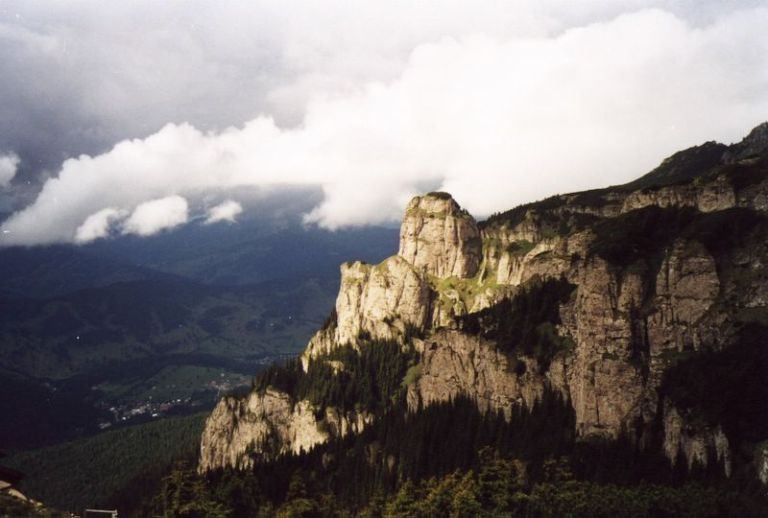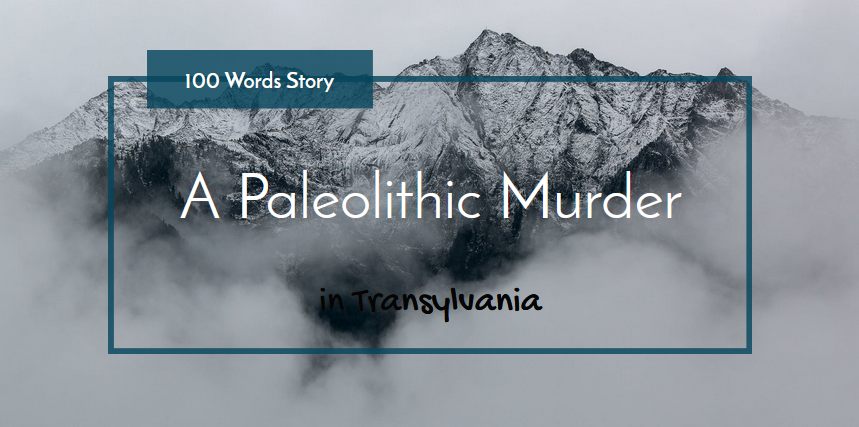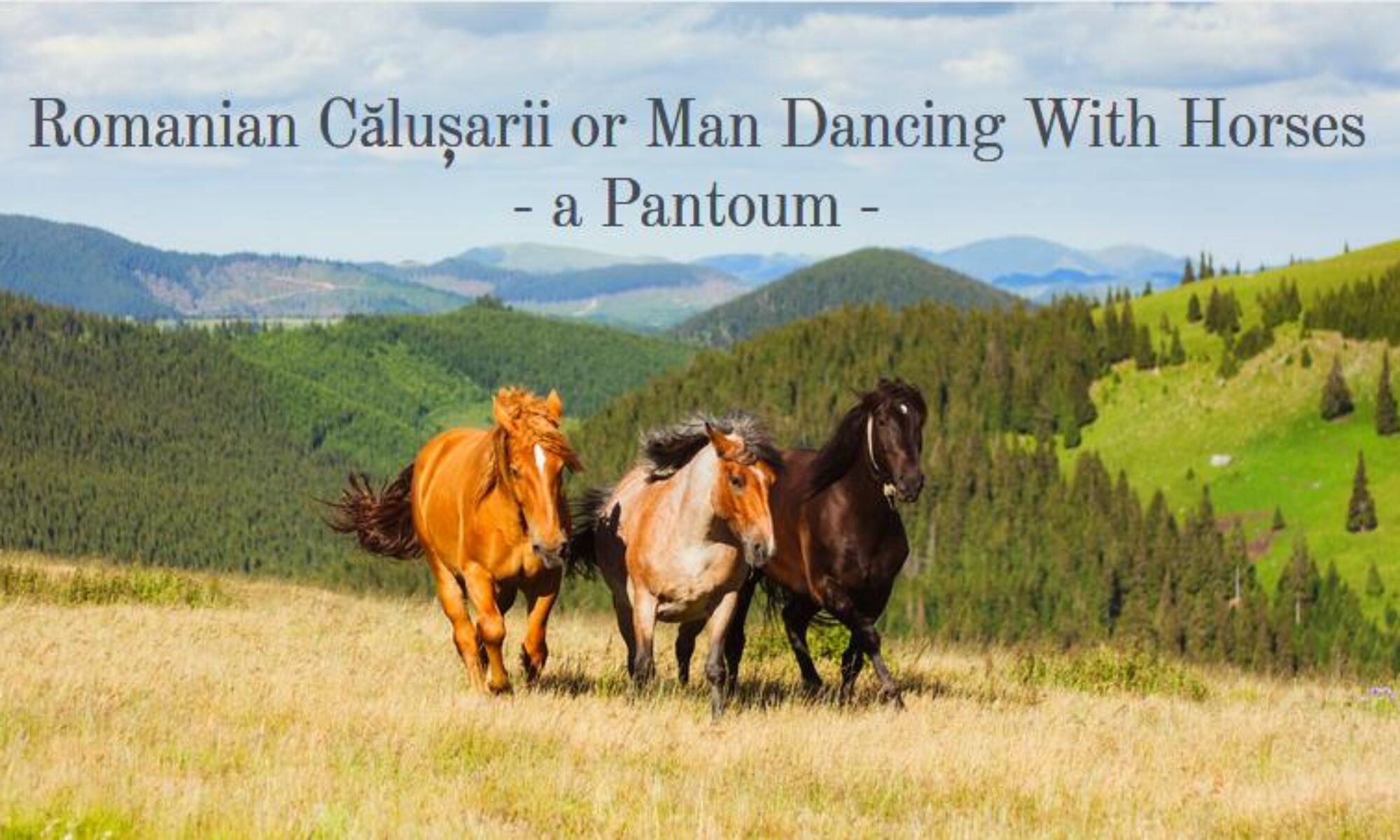Incredible myths and stories of folklore hail from the Romanian woods, this green gold that once covered three quarters of Romania. Throughout centuries, forests fed and sheltered humans from invaders, ‘forest, best buddy bloke of Romanian folk’ goes the ancient saying (Codrul, frate cu romanul), but woods also offered their buds of wisdom and tales.
In Romanian culture, as in many others, the house represents the spiritual center of human life, the place where profane meets sacred and around which gravitates many of the intriguing creatures populating myths (stories and beliefs rooted in human’s origin, often involving gods) and folklore (fictional tales and superstitions, legends, involving fauna, flora and creatures with unusual powers).
A beautiful Romanian myth speaks of a distant time, long, long ago and right after God created the world, when humans needed no shelter for the sky was near and the sun, the moon and all the stars would walk among people. And keep them warm. But then people turned against each other and this made God so sad that he lifted the skies high above, beyond the flight of the birds and the arch of the rainbows, so humans started experiencing the cold and the rain and the sleet and the wind. And to look for a shelter. For the first time. So they found shelter in caves, and in forests until God, in His kindness and love for His creation, inspired humans to build a shelter of wood. And the house became a home.
Apart from building homes, almost always out of trees, especially fir, the wood was used for creating tools and weapons necessary for survival (with the added benefit of iron parts), but also household objects and works of art and spiritual connection with God (the wooden vesper bell), a physical representation of the Romanian spirit.
Listen to the song of the wooden vespers bell of Petru Voda Monastery:
You would have noticed tat the monk bends and touches the ground when he crosses himself. It is to take earth at a witness of his love for God, the earth that was made and blessed by God, but also to show his appreciation towards the earth he lives on.
Wood and Forest Myths from Romania
In Romanian mythology and folklore the cult of the mother (Mother of the Earth, The Mother of the Forest, the Mother of Flowers, the Mother of God, the Mother of the Rain) is widespread and is linked to the mystery existence itself, to the life and death circle of life.
Many were our ancestors’ forests, vast and dense were they, enriched by mysterious creatures, bathed by springs. And countless are the characters that climbed out of the Romanian forests into our folklore, and found refuge in the woods, only to come out in our myths.

Muma Pădurii, The Forest Crone Mother (synonym with Gaia, he ancestral mother of all life in Greek mythology)
Muma Pădurii is a mythological representation of a long ago civilization, mainly focused on woods as she personifies everything that comes out of a forest. She lives in the depths of her realm, in its hollows, safe from the woodcutter’s ax and human sightseeing. She is a sad mother though, for she moans, mourns, sighs, snorts, and wails. People are cutting off her offsprings, the trees.
Muma Pădurii is portrayed as an old and anthropophagous (feeding on human flesh) woman, a patron of evil spirits who populate the forest. She is hideous, her mane reaching the ground, and often the woods resonate of her shrieks. They say this sound is enough to scary any traveler. At night time she can be spotted sleeping near strange fires (for they never burn with wood) or sliding like a ghost, a chimera, through forests and bushes, across the plains and crossroads. And she brings whirlwinds and bad weather, entering homes at midnight. You know it is she, for she slams open doors and windows.
How does she look like?
They say she can take the shape of many animal (be it a mare, buffalo, or cow), or that of a woman looking like a knotty tree, with withered legs, hair like braided strands that fall to the ground, like snakes, a woman dressed in bark or moss. She can be as tall as a house or as small as a rabbit, as beautiful as a fairy or as hideous as a monster with a big head, eyes as big as a dinner plate, teeth as big and as sharp as a sickle. She comes on foot or riding a mare with nine hearts.
If she is hungry for flesh nothing can stand in her way for she knows 99 tricks with which she entices people to leave the safety of their homes and get lost in the forest – where she fries them and eats them.

Some of her children are the spirits of the night, Murgila, Miazanopte, Zorila (Twilight, (Midnight, Daybreak)
They are her sons cursed to always follow each other, yet never to meet, a personification of the passing of the time. And they are ugly, so hideous, always crying, that she constantly tries to exchange them with human children. For this reason, mothers with babies take extra care to guard them till they are baptized (usually between 3 – 6 month in Christian Orthodox tradition). So they don’t let them out of sight, day or night. If they must leave them alone, then a metal object will be placed nearby, for protection. Remember, metal cuts wood. Anything they have, a sickle, scissors, pliers, a silver coin, that they whispered upon, a spell from the heart, a prayer for protection:
‘You, Forest Crone
You, Woodsy bag of bones,
Arriving by cow,
By cow be gone.
From [name] be banned!‘
And:
‘Sickle,magic reaper,
By day thou art be cut,
By night be it to guard,
For [name],
On bed,
Under bed,
On bedding,
Under bedding.‘

And if the baby was changed?
There are various magical practices by which one could bring it back. Thus, a witch or even the child’s mother would lit the fire in the hearth, takes the changeling in her arms (often a baby displaying macrocephaly, a large head, thin, but always hungry) and threatened to throw him into the flames. Of course, faced with such imminent danger Muma Pădurii returns the stolen child.
She will punish robbers yet assist those in need, be it honest fugitives or lost children. Like any mother, she knows each and every tree in her forest, for she nurtured them all since they were but shoots. She scolded them when they grew crooked, and when they upset her she cursed them, to meet the woodcutter’s ax or be struck by lightning.
But her wrath spills into villages too, if women who spin on Tuesdays or pick berries on Saint Mary’s Day (6th of August), or if men whistle or sing in the woods and wake her children.
To defend yourself against her wrath, simply make the sigh of the cross, and if your hands are occupied, make it with your tongue on the roof of your. If you are brave enough and you hear her whimper, ask her, ‘Great Lady, why are you crying?’ – and if she answers ‘ I’m hungry. I haven’t eaten in a week,’ then give her something to eat and you are good to pass through her forests.
As the goddess that she is, a true mother of nature, Muma Pădurii can be also good.
Beneficial, she is the sacred plant Asperula odorata, Wild Baby’s Breath, and also Lathraea squamaria, the common toothwort, used in invoking spells that drive away children’s diseases. But there is a sacred ritual before picking it and only on the night of Sanziene, (23-24 June), in silence, so it won’t get scared nor hide in the ground. The plant is then dried and stored as something of the greatest value, only to be used when needed. As for treatment, it is smoked or used as incense or put in the bath water, always accompanied by a spell.
In case you wondered, there is a Daughter of the Forest too
The Daughter of the Forest lives in the depths of the woods where she emerges from, taking on the appearance of a familiar girl, as sweet as a fairy, brought forward by winds and storms. Like her mother and brothers, she can only travel by night and sometimes she shows herself as a half-girl – half-fish or animal, usually a mare. She only emerges to deceive lads, whom she kidnaps, plays with their minds only to abandon them in the forest, forever lost.


Unlike her harpy mother, the Daughter of the Forest is cheerful, happy, always ready to sing and dance. She is tall and willowy, and her only item of clothing, apart from shoes made of animal skin, is her hair that twirls around her. In winter, perhaps, she chooses to cover herself with moss. From the front, she looks like a woman, but from the back she appear to be the bark of a tree, like the hundreds surrounding her. Brothers, sisters.
To be rid of his maddening love for her, the lost lad can be aided by a witch who crafts a life-size puppet out of straws. The replica is dressed in the young man’s clothes and left by the crossroad, in the woods. Fulled by its appearance, the Daughter of the Forest falls for the puppet thus releasing the lad from the power of her spell. Of her love.
But if the lad wears a belt, she will keep away for she is afraid that he’ll use the belt to tie it around her, squeezing all her secrets out of her.
The Father of the Forest, or Old Man Wood, Moșul Codrului
He is a mythical representation of the wooding craft and of the golden, old age. Moșul Codrului together with Muma Pădurii grows trees and bring life in the forest wherever they go. He has the same physical features as his wife,except that he does not steal children. And he is friendlier.
The Forest Goddesses, Vâlve or Charmstresses
Are said to hold power over herbs, magic flowers, thermal springs, winds, mountains and forests, where they lived among themselves, speaking a language no one understood.

Folktales and folk belief hailing from the Romanian Forests
A very long time ago, Romans (like many other cultures, I am sure), respected trees so much that when they had to cut them down, they first prayed and asked for forgiveness, showing us that they believed the woods to poses a soul.
An important tree in Romanian culture is the beech. In many areas it is used on the celebration of Arminden, May 1st. Beech branches are placed above the windows and stable door, with the belief that they protect against the undead. In some villages of Oltenia, the coffins, called “thrones”, are made only of beech wood.
Another magical tree is the oak. On the Column of Trajan it is depicted that Decebal, the renowned Dacian leader of 87-106 (today Romania) killed himself under an oak tree to escape being taken prisoner by Romans, led by Trajan, after the second Dacian-Roman war. You can read about the Legend of Traian and Dochia and the myth of the Romanian people’s ethnogenesis.


In some areas in Ardeal (western Transylvania) there is still the custom taking the holy communion at Easter time in the form of fir or beech buds, instead of bread and wine, after which they say “Christ Has Risen”.
Situated on the curve of Carpathian Mountains, east of Brasov, is Vrancea county. A place where shepherds confess in front of a fir tree. With the tip of their ax or with the aid of a pocket knife they would craft a cross on the bark of the tree and confess their sins, while making the sign of the cross with their right hand. Then they would remove a few wood chips from the fir tree, and throw them away. If the tree dried out in one year, their sins were forgiven. Holding fir tree in high regards is still a custom today, when a new born is presented to a fir tree, for blessing, in the absence of a priest.
Considering that the Romnaian word for fir, brad, is of Geo-dacic origin, proving the old spiritual connection with this tree, its strong presence in the Romanian spirituality should not surprise us. Also of Geo-dacic origin are the following Romanian words for forest and trees: codru, copac, stejar (oak), mugure (bud).
Biserici de Brazi, The Fir Church
The Fir Church is a cluster of fir trees growing in a circle pattern where young shepherds would choose as a natural church, to mary the girl they loved dearly, but whose parents opposed to the wedding. An old shepherd or even a priest would thus marry them in a Fir Church. The sky and the stars above their heads would be witnesses, in this sacred church of God. The marriage would be out of love, without a dowry.
Folk art involving wood
Worth mentioning is also the Folk-Art ~ Romanian Symbols: when carving in wood, the Romanian folk artists puts a lot of thought. Each carving tells a story, some symbols are for protection, others to remember them of the families left behind:
A cross is for protection.
A cross in a circle symbolizes God.
A circle is for eternity, a dot for perfection.
A diamond represents the woman.


Folk belief:
If yellow clouds lift when wind blows over fir trees, called mana, wealth, a good year will follow.
If you jump three times forward and three times backwards over a stump of wood you will never get lost in a forest. Or in an orchard.
If you cut trees to build a house, leave none stumps behind and say: for the rot, for the fungus, for the mildew…
If you are looking for fir trees free of mildew, better cut them in January or February, under heavy frost. And if you do it in March, do it under the New Moon.
It is for protection that fir branches are placed on the roof of a newly build home, to be strong, and the people living in it to be healthy and happy.
We see fir tree at weddings too, atop a pole, with colorful ribbons attached to it. And a bell.
In Bucovina, NE of Romania, before the sheep are taken into the mountains, the are walked through a Live Fire, smoked with burning branches of fir tree to be free of danger all summer long. Laurel leaves and rosemary are also added to the fir fire.
The sky opens in the night of Saint George (St. Gheorghe), when all trees can flower: walnuts, willow, and all forest trees.
If you hear the eagle owl singing in the forest, know that bad weather will follow.
The groom should never go in the forest or by the water well or bad things will happen to him.
For the first 40 days after the baby was born, he (she)is not removed from the house or Muma Pădurii will take him.
A Romanian spooky forest
Located west of Cluj-Napoca, in the north of Romania, Hoia Forest is considered one of the spookiest places in the world. Because trees grow different here. Of course, ghost sighting and UFOs have been observed here, earning this woodland the nickname of “Romania’s Bermuda Triangle”.
But spots of light have been shooting from the forest, without a reasonable explanation. The locals say that the trees are thus curved because they are nothing else but the souls of those lost in this place.
Worth mentioning is that a wind called Austrul, hot and dry, blows at 20-30 km/h in this western part of Transylvania.

Did you know?
Transylvania means ‘the land beyond the forest” (the forest of Apuseni Muntains).
Bucovina means “strawberry forest” in Slavonic.
Also on my blog…


As always, discover all my books on Amazon.

Nu-mi vine sa cred. Padurea asta este la mine în tara??!!!!
Da da 🙂
Scuza-ma Jo. Comentariul tau intrase in dosarul “spam” pe care am uitat sa-l verific.
Mersi mult pentru vizita!
The hoia forest picture is amazing, no wonder people think that’s a haunted forest.
I know! Although it MUST be a logical explanation. Although that will take away from its charm.
Lovely seeing you, Priscilla 🙂 Hope your Pitch practice is fruitful.
How are the forests in Romania today? Enjoyed your stories.
This not an easy question, Michael.
From what I understood browsing various websites, the situation is vile due to illegal deforestation. sigh
But we still have might forests 🙂 And bears 😉
Kind thanks for your visit. Have a blessed weekend.
Sad news, sorry